Multi-Objective Optimization of Graded Thermal Storage System for Direct Steam Generation with Dish Concentrators
Abstract
1. Introduction
2. System and Method
2.1. System Introduction
2.2. Theoretical Method of the TES System
2.3. Economic Calculation Method for TES System
2.3.1. Calculation of TES Tank Parameters
2.3.2. Cost Calculation of the TES System
2.4. Optimization Design Analysis Method
2.4.1. Response Surface Method
2.4.2. Data-Driven Surrogate Model
2.4.3. Multi-Objective Optimization Method
3. Results and Discussion
3.1. Analysis of Influencing Factors
3.1.1. The Effect of ms of TES Material on the Graded TES
3.1.2. Effect of TS on the Graded TES System
3.1.3. Effect of the TES Material Rm on the Graded TES System
3.2. Response Surface Method
3.3. Rapid System Prediction Model Based on Support Vector Machine
3.4. Multi-Objective Optimization Based on the NSGA-II Algorithm
4. Conclusions
- Using the response surface method as the objective function, the significance of the impact of the three factors is studied. The results show that the system TS and the Rm of the sensible TES material have a significant impact on the system cost, and there is an optimal mass flow of sensible TES material, thereby maximizing the overall performance of the system.
- The rapid cost prediction model of the graded TES based on SVM is trained. The results showed that the predicted cost was in good agreement with the thermodynamic calculation results. The maximum error is 3.26%, and the average error is 0.82%, which aligns with the demand for rapid performance prediction of the graded TES system.
- By comparing the REx and cost corresponding to design point C obtained from the multi-objective optimization with the thermodynamic calculation results, the REx calculation result after optimization was 11.01% higher than that before optimization, and the cost calculation result after optimization was 585,000 yuan less than that before optimization. Its accuracy is at a high level, and the optimization effect is obvious.
Author Contributions
Funding
Data Availability Statement
Conflicts of Interest
Abbreviations
| Q | heat quantity (kJ) |
| p | working pressure (MPa) |
| t | time (h) |
| efficiency (%) | |
| Ex | exergy(W) |
| cp | specific heat (J/kg·K) |
| T | temperature (℃) |
| H | enthalpy (J) |
| S | entropy (J/K) |
| V | volume (m3) |
| n | ratio of the tank’s inner diameter and height (-) |
| C | cost (RMB) |
| density | |
| Greek letters | |
| ε | efficiency of heat exchanger[-] |
| Δ | difference[-] |
| Subscripts | |
| 0 | turbo-generator |
| e | environment |
| c | cold |
| h | hot |
| sm | Thermal energy storage material |
| st | steel material |
| * | unit price |
| TES | Thermal energy storage |
| STP | solar thermal power |
| ANN | artificial neural network |
| SVM | support vector machine |
| NSGA | nondominated sorting genetic algorithm |
| CCD | central composite design |
| BBD | Box–Behnken design |
References
- Al-Habaibeh, A.; Shakmak, B.; Fanshawe, S. Assessment of a novel technology for a stratified hot water energy storage—The water snake. Appl. Energy 2018, 222, 189–198. [Google Scholar] [CrossRef]
- Guo, S.; Liu, Q.; Sun, J.; Jin, H. A review on the utilization of hybrid renewable energy. Renew. Sustain. Energy Rev. 2018, 91, 1121–1147. [Google Scholar] [CrossRef]
- Liu, L.; Wang, R.; Wang, Y.; Li, W.; Sun, J.; Guo, Y.; Qu, W.; Li, W.; Zhao, C. Comprehensive analysis and optimization of combined cooling heating and power system integrated with solar thermal energy and thermal energy storage. Energy Convers. Manag. 2023, 275, 116464. [Google Scholar] [CrossRef]
- Ravi Kumar, K.; Krishna Chatanya, N.V.V.; Sendhil Kumar, N. Solar thermal energy technologies and its applications for process heating and power generation—A review. J. Clean. Prod. 2021, 282, 125296. [Google Scholar] [CrossRef]
- Zayed, M.E.; Zhao, J.; Li, W.; Sadek, S.; Elsheikh, A.H. Applications of Artificial Neural Networks in Concentrating Solar Power Systems. In Artificial Neural Networks for Renewable Energy Systems and Manufacturing Applications; Academic Press: Cambridge, MA, USA, 2021. [Google Scholar]
- Behar, O. Solar thermal power plants—A review of configurations and performance comparison. Renew. Sustain. Energy Rev. 2018, 92, 608–627. [Google Scholar] [CrossRef]
- Zayed, M.E.; Zhao, J.; Elsheikh, A.H.; Li, W.; Sadek, S.; Aboelmaaref, M.M. A comprehensive review on Dish/Stirling concentrated solar power systems: Design, optical and geometrical analyses, thermal performance assessment, and applications. J. Clean. Prod. 2021, 283, 124664. [Google Scholar] [CrossRef]
- Milian, Y.E.; Ushak, S.; Cabeza, L.F.; Grageda, M. Advances in the development of latent heat storage materials based on inorganic lithium salts. Sol. Energy Mater. Sol. Cells 2020, 208, 110344. [Google Scholar] [CrossRef]
- Suresh, C.; Saini, R.P. Thermal performance of sensible and latent heat thermal energy storage systems. Int. J. Energy Res. 2020, 44, 4743–4758. [Google Scholar] [CrossRef]
- Ben Khedher, N.; Bantan, R.A.; Kolsi, L.; Omri, M. Performance investigation of a vertically configured LHTES via the combination of nano-enhanced PCM and fins: Experimental and numerical approaches. Int. Commun. Heat Mass Transf. 2022, 137, 106246. [Google Scholar] [CrossRef]
- Ben Khedher, N.; Ben Nasrallah, S. Three-Dimensional Simulation of a porous thermal energy storage system using solid-liquid phase change material. J. Porous Media 2011, 14, 777–790. [Google Scholar]
- Wang, K.; Jia, P.-S.; Zhang, Y.; Zhang, Z.-D.; Wang, T.; Min, C.-H. Thermal-fluid-mechanical analysis of tubular solar receiver panels using supercritical CO2 as heat transfer fluid under non-uniform solar flux distribution. Sol. Energy 2021, 223, 72–86. [Google Scholar] [CrossRef]
- Malviya, R.; Agrawal, A.; Baredar, P.V. A comprehensive review of different heat transfer working fluids for solar thermal parabolic trough concentrator. Mater. Today Proc. 2021, 46, 5490–5500. [Google Scholar] [CrossRef]
- Yilmazoglu, M.Z. Effects of the selection of heat transfer fluid and condenser type on the performance of a solar thermal power plant with technoeconomic approach. Energy Convers. Manag. 2016, 111, 271–278. [Google Scholar] [CrossRef]
- Laing, D.; Bahl, C.; Bauer, T.; Lehmann, D.; Steinmann, W.-D. Thermal energy storage for direct steam generation. Sol. Energy 2011, 85, 627–633. [Google Scholar] [CrossRef]
- Eck, M.; Eickhoff, M.; Fontela, P.; Gathmann, N.; Meyer-Grünefeldt, M.; Hillebrand, S.J.; Schulte-Fischedick, J. Direct Steam Generation in parabolic troughs at 500 °C—First results of the REAL-DISS project. In Proceedings of the 17th Solar PACES Conference, Granada, Spain, 20–23 September 2011. [Google Scholar]
- Seitz, M.; Cetin, P.; Eck, M. Thermal storage concept for solar thermal power plants with direct steam generation. Energy Procedia 2014, 49, 993–1002. [Google Scholar] [CrossRef]
- Eck, M.; Eickhoff, M.; Fontela, P.; Laing, D.; Meyer-Grünefeldt, M.; Möllenhoff, M.; Nölke, M.; Vives, F.O.; Riffelmann, K.-J.; Sanchez-Biezma, A.; et al. Test and demonstration of the direct steam generation (DSG) at 500 °C. In Proceedings of the Solar PACES 2009—Electricity, Fuels and Clean Water Powered by the Sun, Berlin, Germany, 15–18 September 2009. [Google Scholar]
- Chen, Q.; Liang, X.-G.; Guo, Z.-Y. Entransy theory for the optimization of heat transfer—A review and update. Int. J. Heat Mass Transf. 2013, 63, 65–81. [Google Scholar] [CrossRef]
- Bian, R.; Deng, Y.; Feng, C. Performance and optimization study of graded thermal storage system for direct steam generation dish type solar thermal power. 2022; under review. [Google Scholar]
- Gumar, A.K.; Demir, F. Solar photovoltaic power estimation using meta-optimized neural networks. Energies 2022, 15, 8669. [Google Scholar] [CrossRef]
- Cortes, C.; Vapnik, V. Support-Vector Networks. Mach. Learn. 1995, 20, 273–297. [Google Scholar] [CrossRef]
- Zhang, J.; Zhu, H.; Yang, C.; Li, Y.; Wei, H. Multi-objective shape optimization of helico-axial multiphase pump impeller based on NSGA-II and ANN. Energy Convers. Manag. 2011, 52, 538–546. [Google Scholar] [CrossRef]
- Verma, S.; Pant, M.; Snasel, V. A Comprehensive Review on NSGA-II for Multi-Objective Combinatorial Optimization Problems. IEEE Access 2021, 9, 57757–57791. [Google Scholar] [CrossRef]
- Deb, K.; Pratap, A.; Agarwal, S.; Meyarivan, T.A.M.T. A fast and elitist multiobjective genetic algorithm: NSGA-II. IEEE Trans. Evol. Comput. 2002, 6, 182–197. [Google Scholar] [CrossRef]
- Hoseini Rahdar, M.; Heidari, M.; Ataei, A.; Choi, J.-K. Modeling and optimization of R-717 and R-134a ice thermal energy storage air conditioning systems using NSGA-II and MOPSO algorithms. Appl. Therm. Eng. 2016, 96, 217–227. [Google Scholar] [CrossRef]
- Yuan, X.; Cheng, W. Multi-objective optimization of household refrigerator with novel heat-storage condensers by Genetic algorithm. Energy Convers. Manag. 2014, 84, 550–561. [Google Scholar] [CrossRef]
- Li, Y.; Liu, G.; Liu, X.; Liao, S. Thermodynamic multi-objective optimization of a solar-dish Brayton system based on maximum power output, thermal efficiency and ecological performance. Renew. Energy 2016, 95, 465–473. [Google Scholar] [CrossRef]
- Gao, D.; Li, J.; Ren, X.; Hu, T.; Pei, G. A novel direct steam generation system based on the high-vacuum insulated flat plate solar collector. Renew. Energy 2022, 197, 966–977. [Google Scholar] [CrossRef]
- Hirsch, T.; Eck, M. Design of a phase separation system for a direct steam generation parabolic trough collector field. J. Sol. Energy Eng. -Trans. Asme 2008, 130, 011003. [Google Scholar] [CrossRef]
- Zarza, E.; Valenzuela, L.; León, J.; Hennecke, K.; Eck, M.; Weyers, H.-D.; Eickhoff, M. Direct steam generation in parabolic troughs: Final results and conclusions of the DISS project. Energy 2004, 29, 635–644. [Google Scholar] [CrossRef]
- Li, X.; Xu, E.; Song, S.; Wang, X.; Yuan, G. Dynamic simulation of two-tank indirect thermal energy storage system with molten salt. Renew. Energy 2017, 113, 1311–1319. [Google Scholar] [CrossRef]
- Peiró, G.; Prieto, C.; Gasia, J.; Jové, A.; Miró, L.; Cabeza, L.F. Two-tank molten salts thermal energy storage system for solar power plants at pilot plant scale: Lessons learnt and recommendations for its design, start-up and operation. Renew. Energy 2018, 121, 236–248. [Google Scholar] [CrossRef]
- Wan, Z.; Wei, J.; Qaisrani, M.A.; Fang, J.; Tu, N. Evaluation on thermal and mechanical performance of the hot tank in the two-tank molten salt heat storage system. Appl. Therm. Eng. 2020, 167, 114775. [Google Scholar] [CrossRef]
- Bejan, A. Entropy Generation Minimization. In Advanced Engineering Thermodynamics; John Wiley & Sons: New York, NY, USA, 1995. [Google Scholar]
- Guo, J.; Huai, X.; Cheng, K. The comparative analysis on thermal storage systems for solar power with direct steam generation. Renew. Energy 2018, 115, 217–225. [Google Scholar] [CrossRef]
- Guo, J.; Huai, X. Optimization design of heat exchanger in an irreversible regenerative Brayton cycle system. Appl. Therm. Eng. 2013, 58, 77–84. [Google Scholar] [CrossRef]
- Shah, R.K.; Sekulic, D.P. Fundamentals of heat exchanger design. In Fundamentals of Heat Exchanger Design; John Wiley & Sons: New York, NY, USA, 2002. [Google Scholar]
- Yusri, I.M.; Abdul Majeed, A.P.P.; Mamat, R.; Ghazali, M.F.; Awad, O.I.; Azmi, W.H. A review on the application of response surface method and artificial neural network in engine performance and exhaust emissions characteristics in alternative fuel. Renew. Sustain. Energy Rev. 2018, 90, 665–686. [Google Scholar] [CrossRef]
- Mohammadi, M.M.; Vossoughi, M.; Feilizadeh, M.; Rashtchian, D.; Moradi, S.; Alemzadeh, I. Effects of electrophoretic deposition parameters on the photocatalytic activity of TiO2 films: Optimization by response surface methodology. Colloids Surf. A Physicochem. Eng. Asp. 2014, 452, 1–8. [Google Scholar] [CrossRef]
- Shan, Z.; Luo, H.; Qin, S.H. Polymer ratio optimization based on support vector machine and genetic algorithm. Appl. Mech. Mater. 2013, 444–445, 1026–1032. [Google Scholar] [CrossRef]


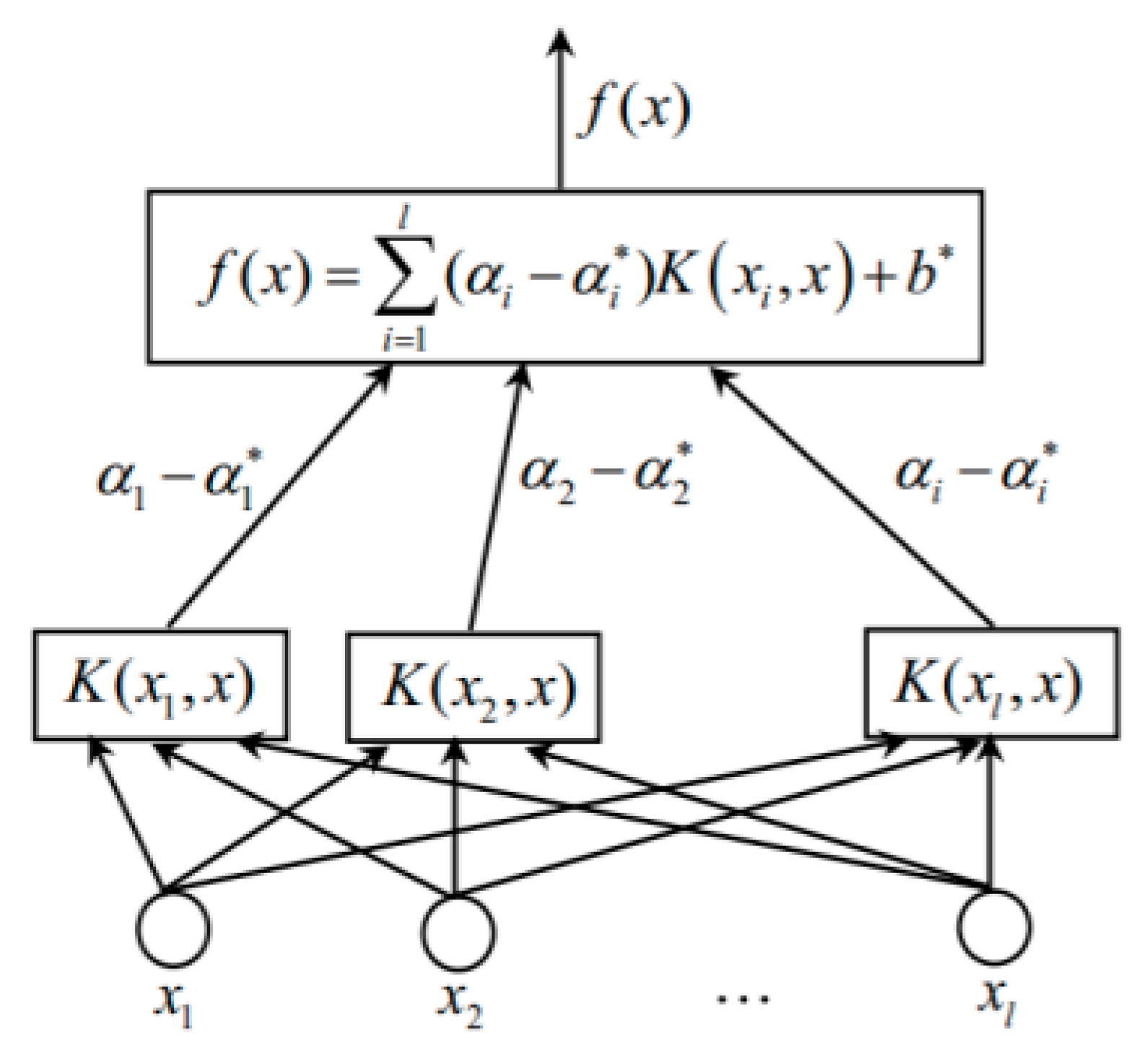




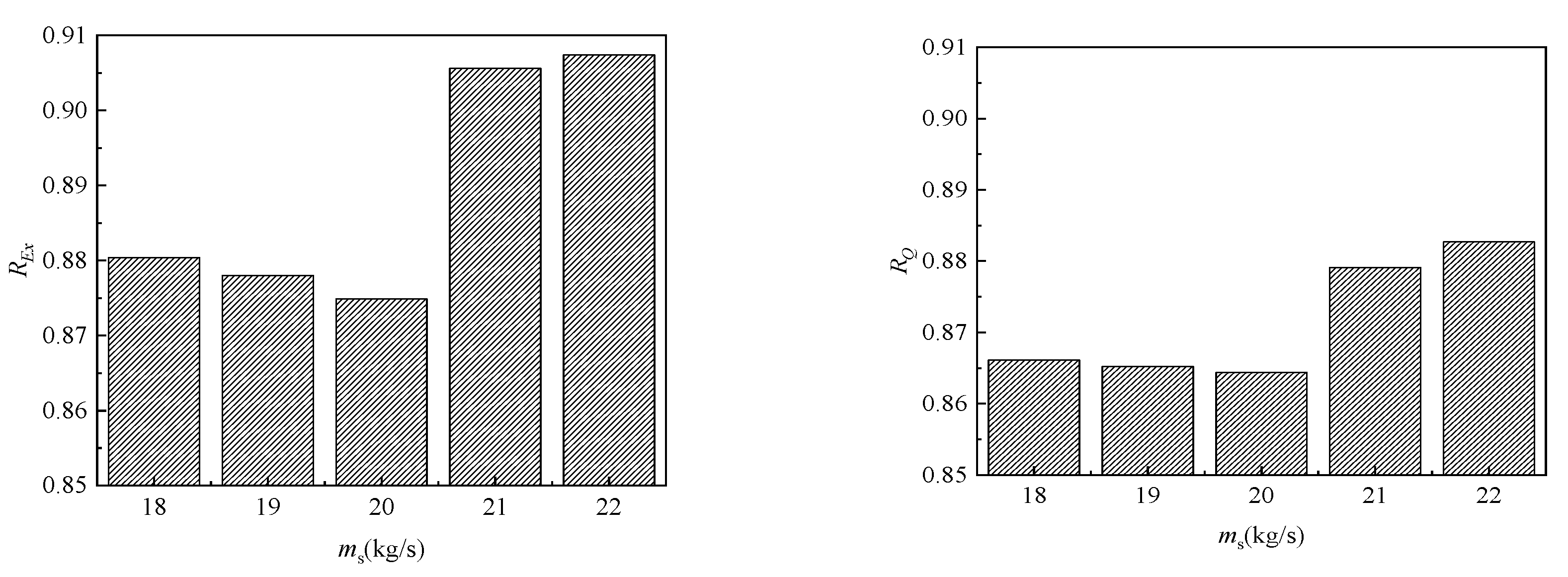

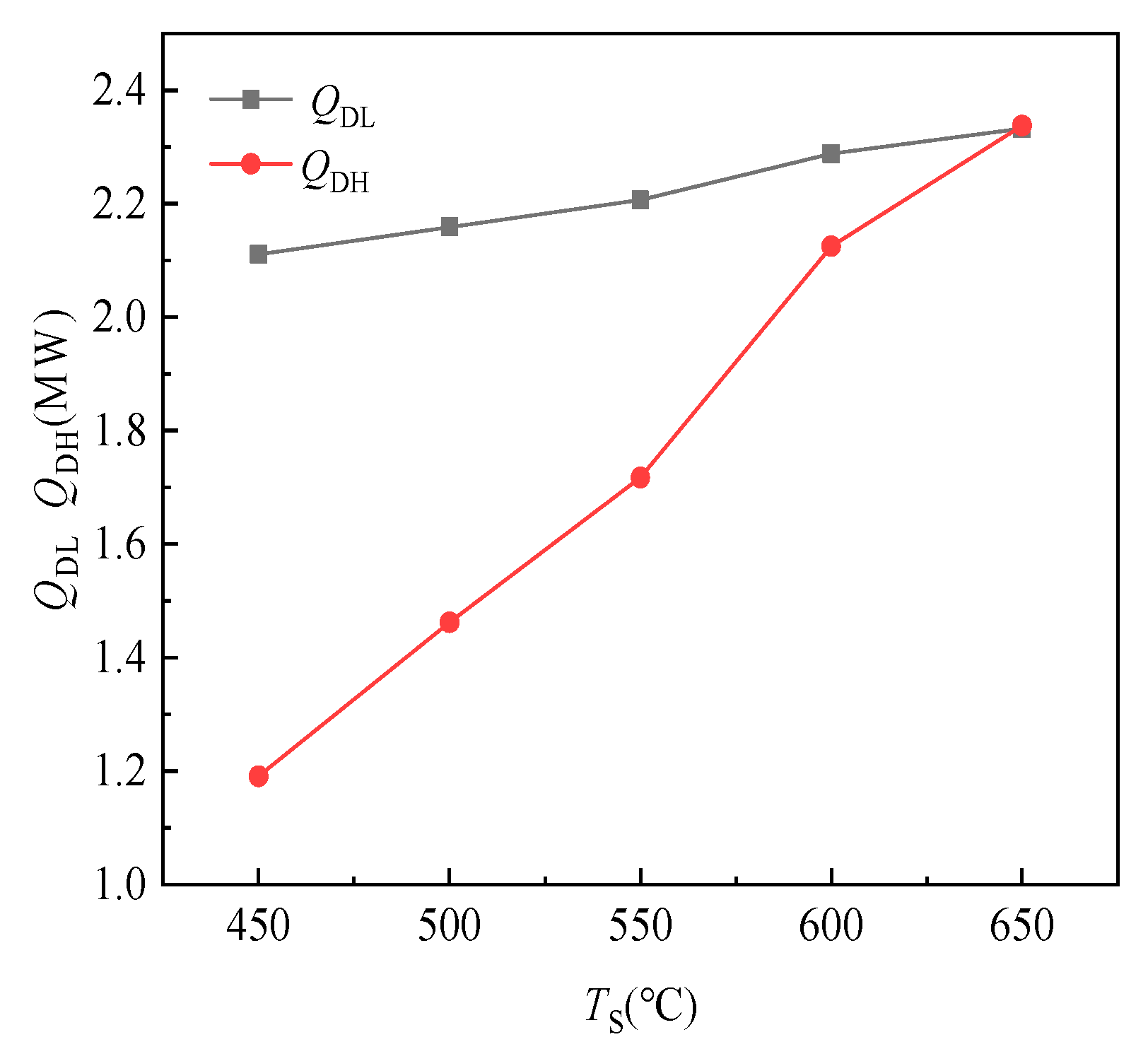
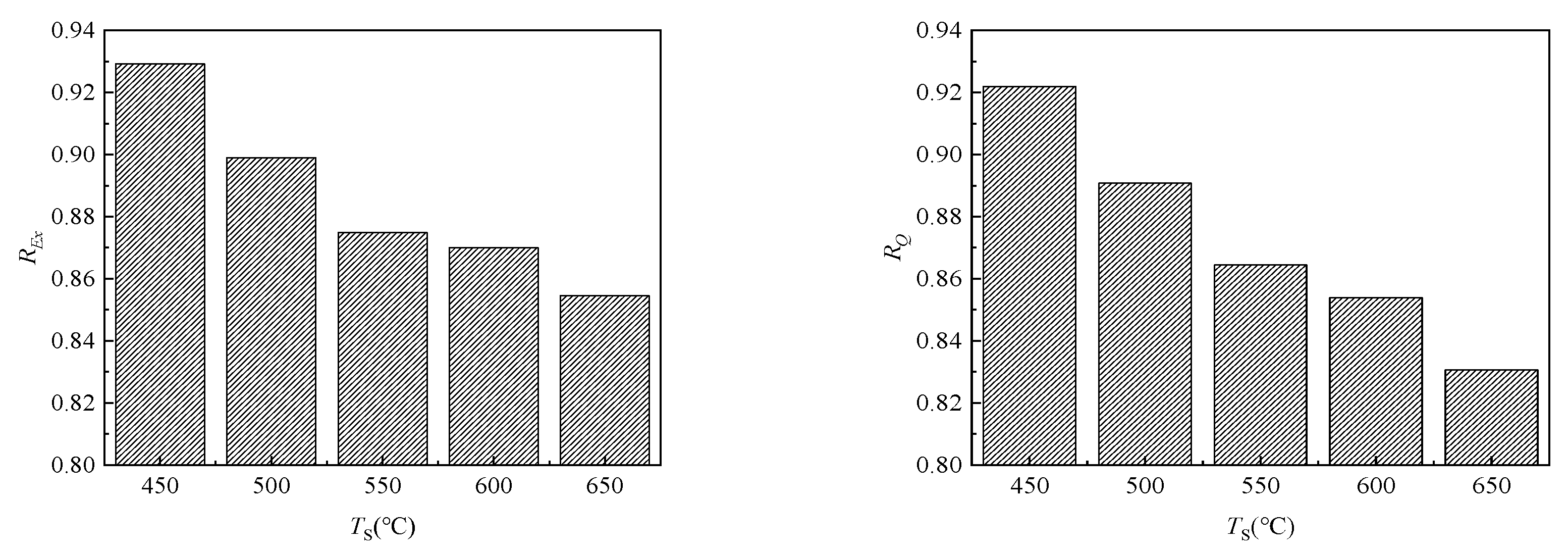
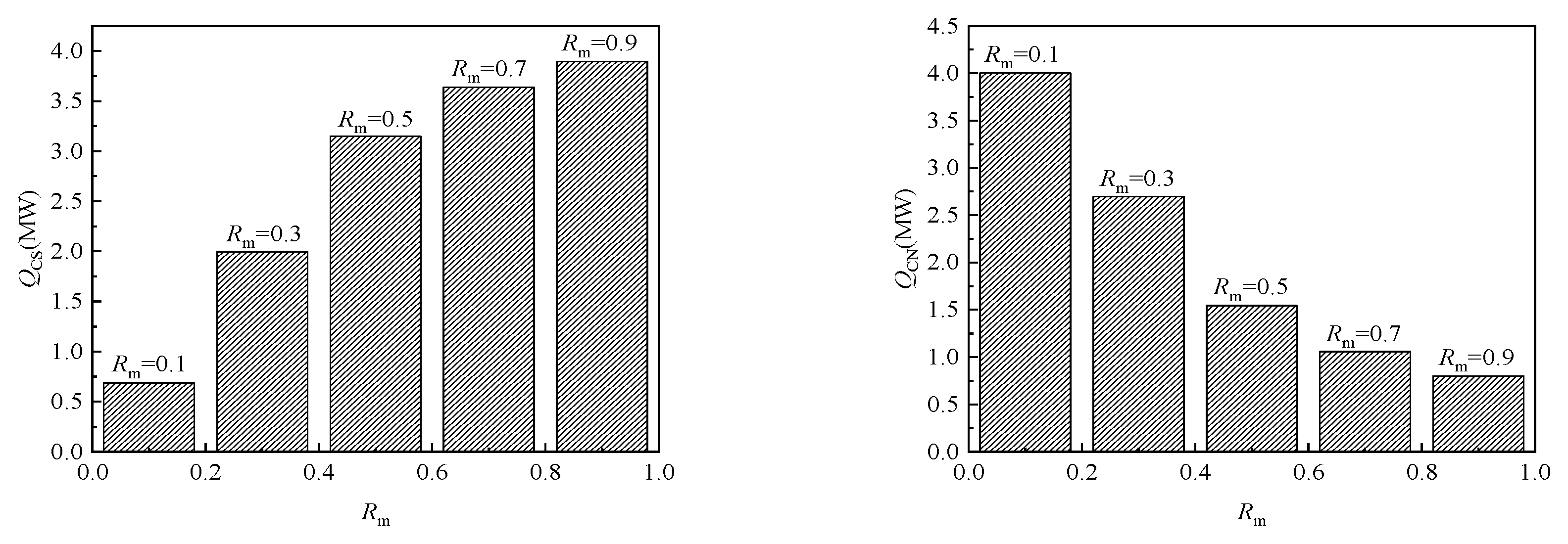
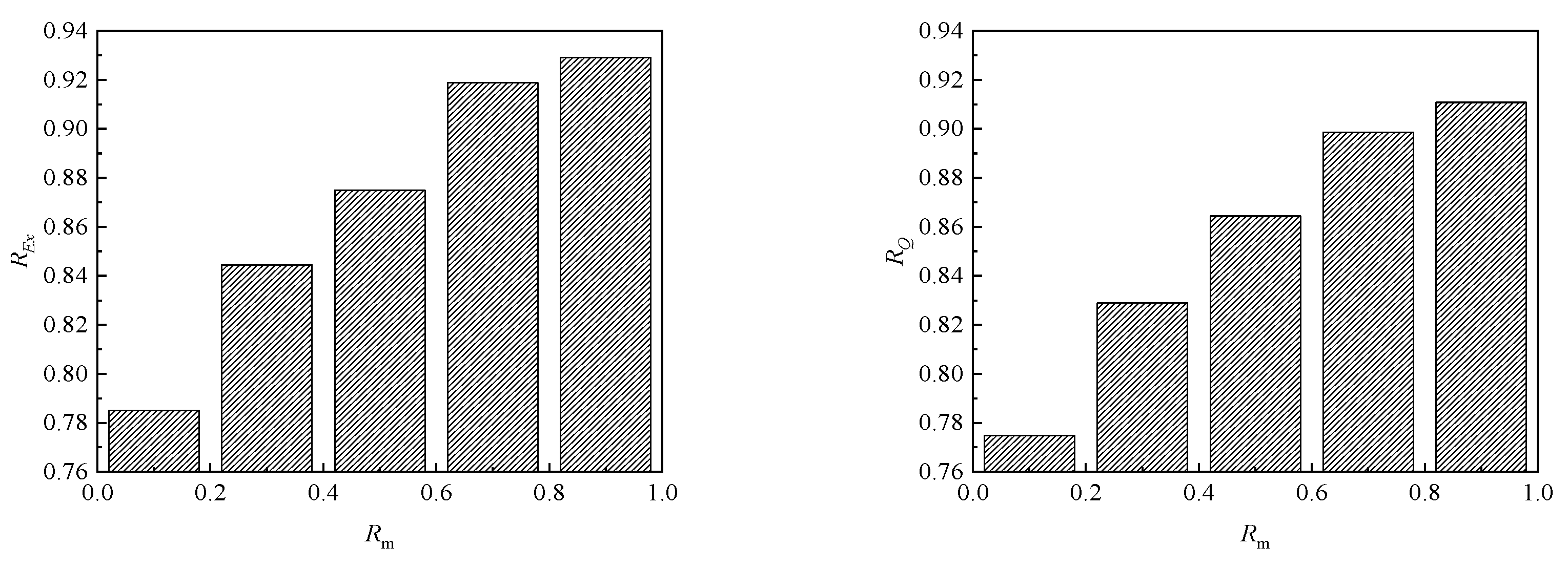
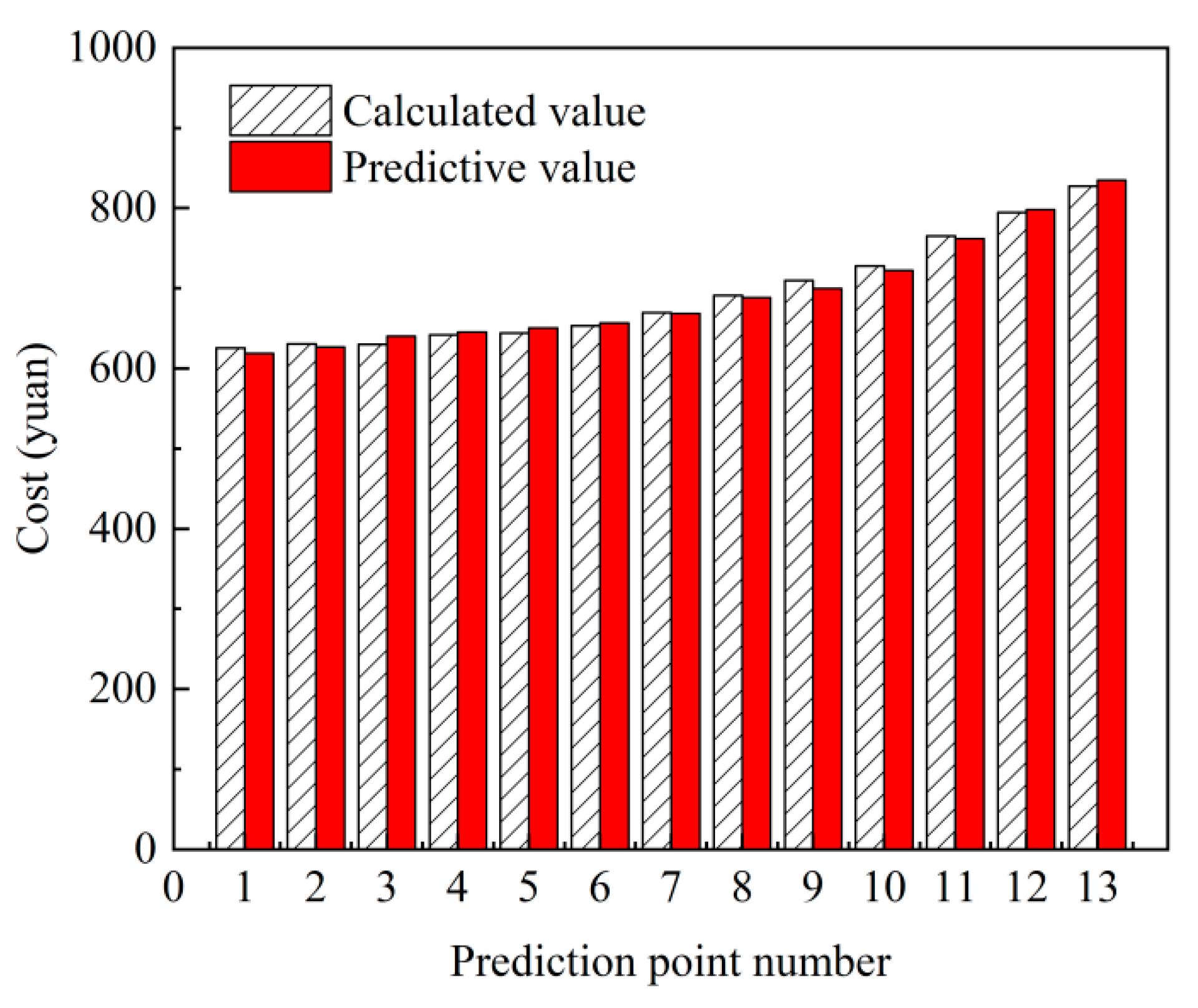
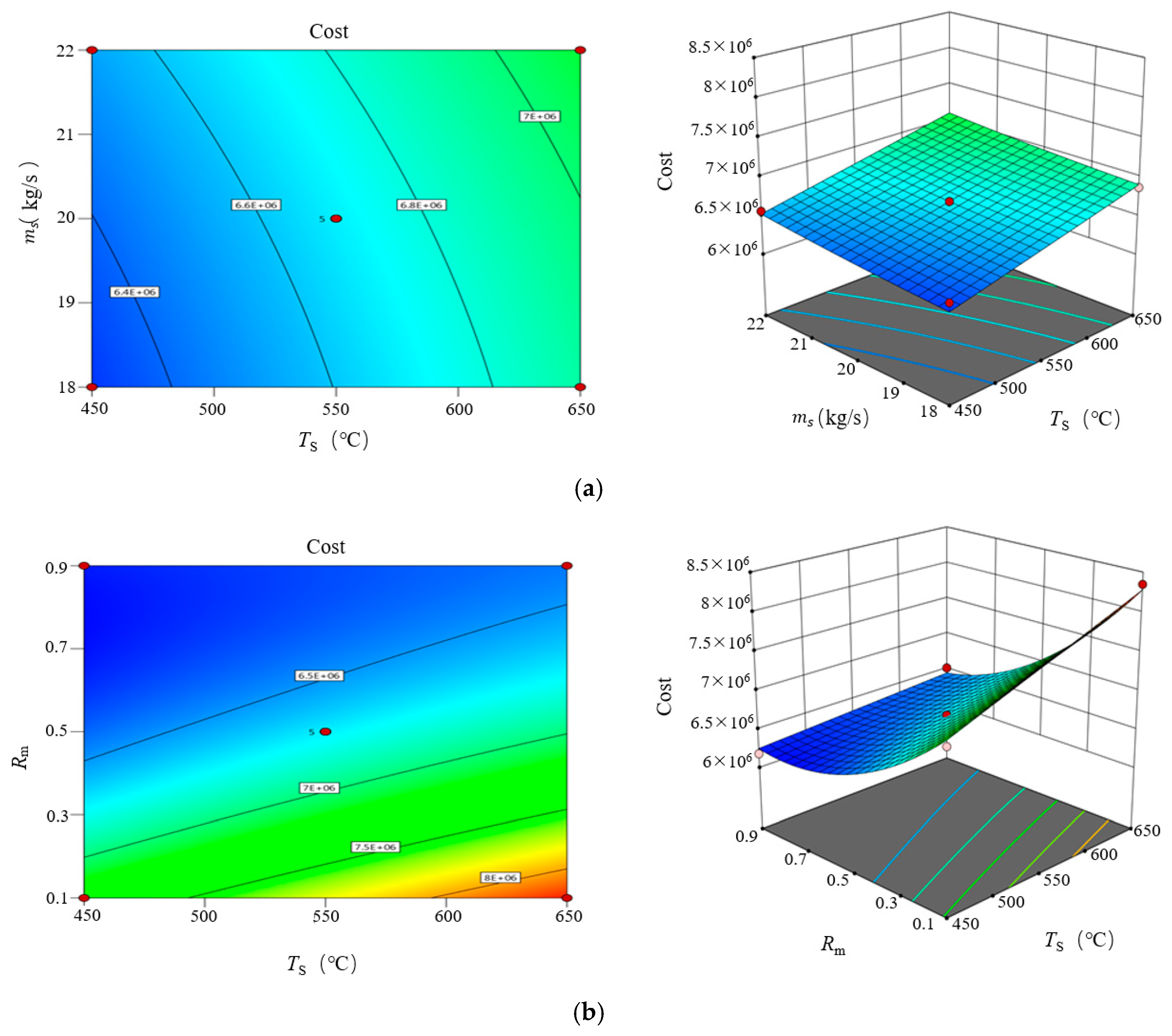



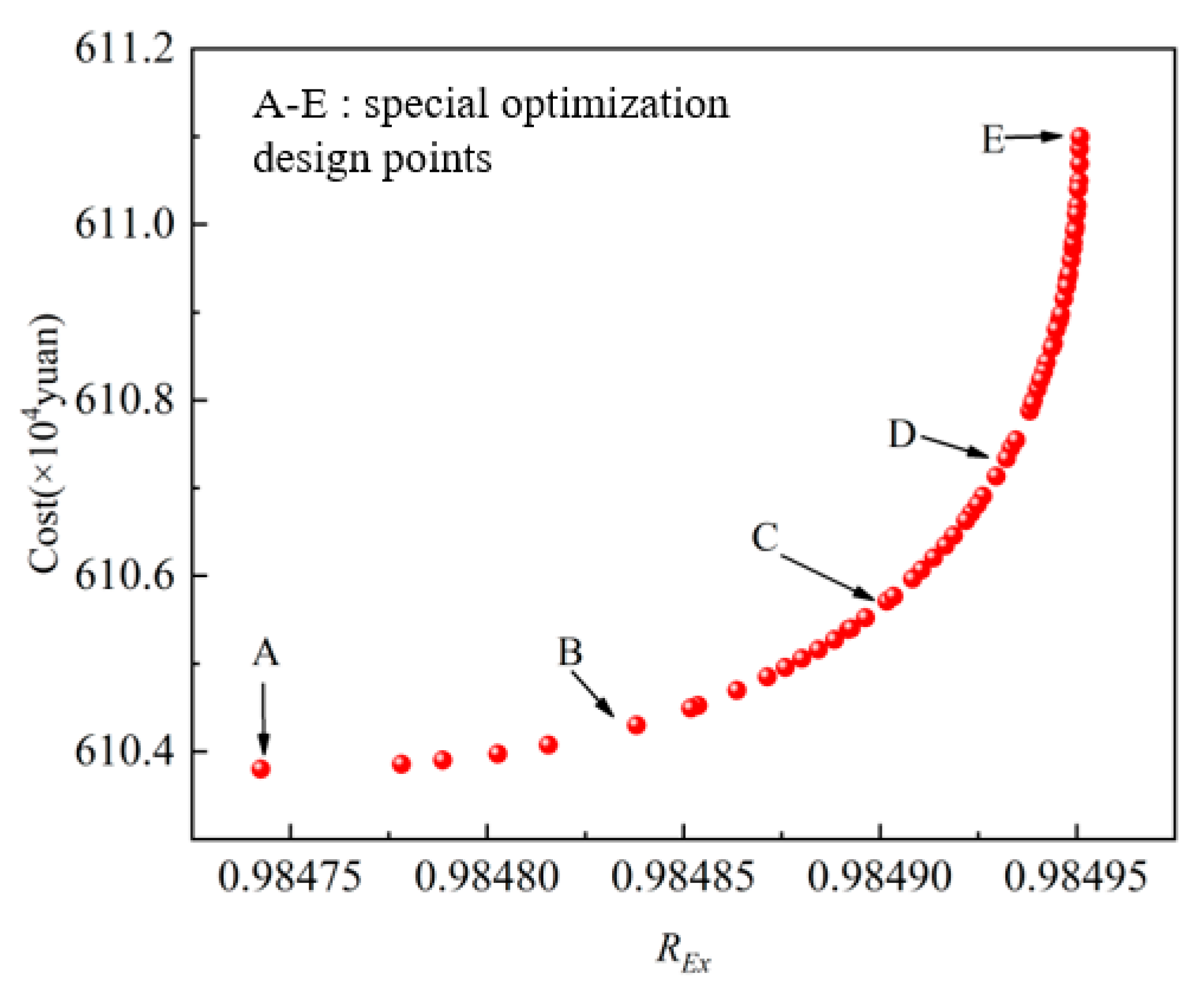
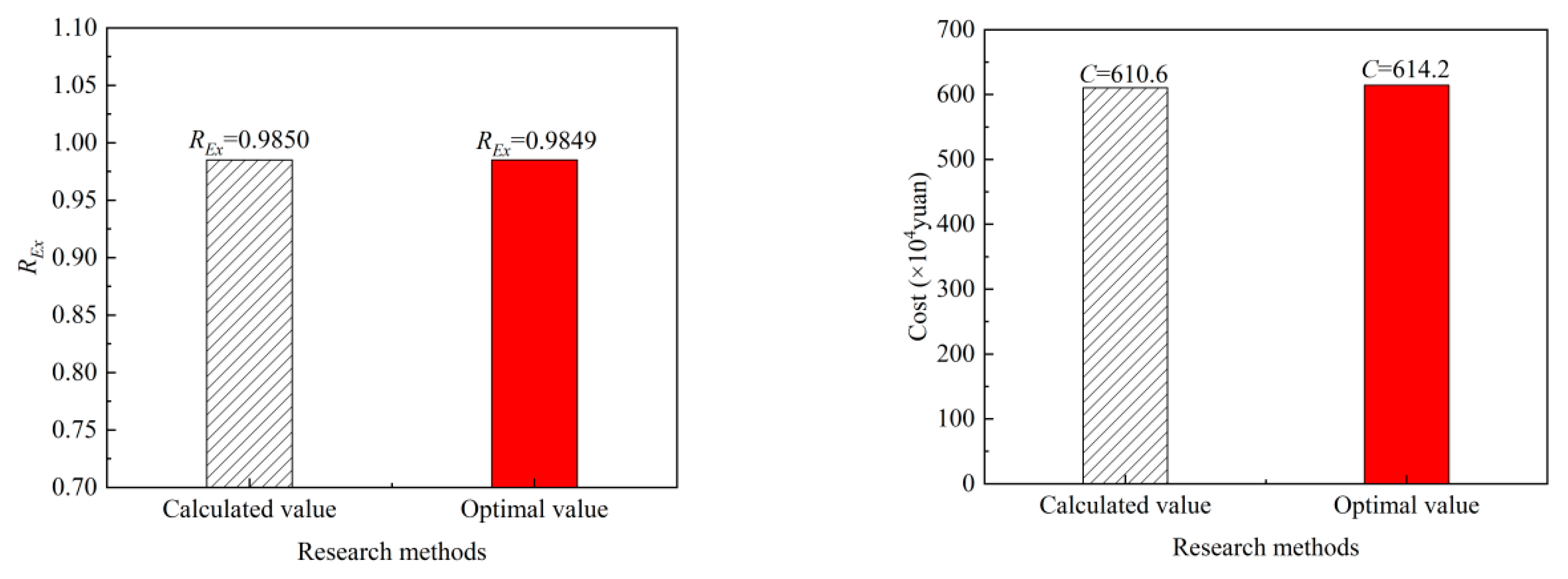

| Parameter | Numeric (RMB/t) |
|---|---|
| NaNO3 | 2548 |
| Solar Salt | 3388 |
| Steel tanks | 19,403 |
| Number | Rm | Ts (℃) | ms (kg/s) |
|---|---|---|---|
| 1 | 0.5 | 650 | 18 |
| 2 | 0.9 | 550 | 22 |
| 3 | 0.5 | 450 | 22 |
| 4 | 0.1 | 450 | 20 |
| 5 | 0.9 | 550 | 18 |
| 6 | 0.5 | 550 | 20 |
| 7 | 0.9 | 650 | 20 |
| 8 | 0.5 | 450 | 18 |
| 9 | 0.5 | 550 | 20 |
| 10 | 0.5 | 650 | 22 |
| 11 | 0.1 | 550 | 18 |
| 12 | 0.5 | 550 | 20 |
| 13 | 0.1 | 650 | 20 |
| 14 | 0.9 | 450 | 20 |
| 15 | 0.1 | 550 | 22 |
| 16 | 0.5 | 550 | 20 |
| 17 | 0.5 | 550 | 20 |
| Parameter | Values |
|---|---|
| Population | 200 |
| Probability of crossing: Pc | 0.85 |
| Probability of variation: Pm | 0.1 |
| Number of iterations | 500 |
| Number | ms (kg/s) | Ts (℃) | Rm |
|---|---|---|---|
| Benchmark | 20 | 550 | 0.5 |
| 1 | 18 | 550 | 0.1 |
| 2 | 19 | 550 | 0.3 |
| 3 | 20 | 550 | 0.5 |
| 4 | 21 | 550 | 0.7 |
| 5 | 22 | 550 | 0.9 |
| 6 | 20 | 450 | 0.5 |
| 7 | 20 | 500 | 0.5 |
| 8 | 20 | 550 | 0.5 |
| 9 | 20 | 600 | 0.5 |
| 10 | 20 | 650 | 0.5 |
| 11 | 20 | 550 | 0.5 |
| 12 | 20 | 550 | 0.5 |
| 13 | 20 | 550 | 0.5 |
| 14 | 20 | 550 | 0.5 |
| 15 | 20 | 550 | 0.5 |
| Design Variables | Optimization Results |
|---|---|
| Rm | 0.9 |
| TS | 450 °C |
| ms | 19.1 kg/s |
Disclaimer/Publisher’s Note: The statements, opinions and data contained in all publications are solely those of the individual author(s) and contributor(s) and not of MDPI and/or the editor(s). MDPI and/or the editor(s) disclaim responsibility for any injury to people or property resulting from any ideas, methods, instructions or products referred to in the content. |
© 2023 by the authors. Licensee MDPI, Basel, Switzerland. This article is an open access article distributed under the terms and conditions of the Creative Commons Attribution (CC BY) license (https://creativecommons.org/licenses/by/4.0/).
Share and Cite
Zhu, Z.; Bian, R.; Deng, Y.; Yu, B.; Sun, D. Multi-Objective Optimization of Graded Thermal Storage System for Direct Steam Generation with Dish Concentrators. Energies 2023, 16, 2404. https://doi.org/10.3390/en16052404
Zhu Z, Bian R, Deng Y, Yu B, Sun D. Multi-Objective Optimization of Graded Thermal Storage System for Direct Steam Generation with Dish Concentrators. Energies. 2023; 16(5):2404. https://doi.org/10.3390/en16052404
Chicago/Turabian StyleZhu, Zhengyue, Ruihao Bian, Yajun Deng, Bo Yu, and Dongliang Sun. 2023. "Multi-Objective Optimization of Graded Thermal Storage System for Direct Steam Generation with Dish Concentrators" Energies 16, no. 5: 2404. https://doi.org/10.3390/en16052404
APA StyleZhu, Z., Bian, R., Deng, Y., Yu, B., & Sun, D. (2023). Multi-Objective Optimization of Graded Thermal Storage System for Direct Steam Generation with Dish Concentrators. Energies, 16(5), 2404. https://doi.org/10.3390/en16052404






